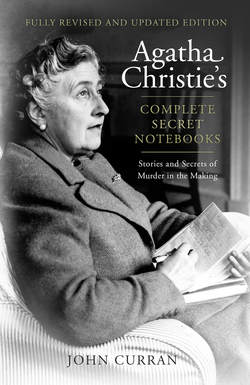Читать книгу Agatha Christie’s Complete Secret Notebooks - Агата Кристи, Agatha Christie, Detection Club The - Страница 13
Poirot Investigates …
ОглавлениеIn An Autobiography Christie gives a detailed account of the genesis of The Mysterious Affair at Styles. By now the main facts are well known: the immortal challenge – ‘I bet you can’t write a good detective story’ – from her sister Madge, the arrival in Torquay of First World War Belgian refugees who inspired Poirot’s nationality, Christie’s knowledge of poisons from her work in the local dispensary, her intermittent work on the book and its eventual completion during a two-week seclusion in the Moorland Hotel, at the encouragement of her mother. This was not her first literary effort, nor was she the first member of her family with literary aspirations. Both her mother and sister Madge wrote, and Madge actually had a play, The Claimant, produced in the West End before Agatha did. Agatha had already written a long dreary novel (her own words) and a few stories and sketches. She had even had a poem published in the local newspaper. While the story of the bet is plausible, it is clear that this alone would not be spur enough to plot, sketch and write a successful book. There was obviously an inherent gift and a facility with the written word.
Although she began writing the novel in 1916 (The Mysterious Affair at Styles is actually set in 1917), it was not published for another four years. And its publication was to demand consistent determination on its author’s part as more than one publisher declined the manuscript. Until, in 1919, John Lane, The Bodley Head asked to meet her with a view to publication. But, even then, the struggle was far from over.
The contract, dated 1 January 1920, that John Lane offered Christie took advantage of her publishing naivety. (Remarkably, the actual contract is for The Mysterious Affair of Styles.) She was to get 10 per cent only after 2,000 copies were sold in the UK and she was contracted to produce five more. This clause led to much correspondence over the following years. Possibly because she was so delighted to be published or because she had no intention then of pursuing a writing career, it is entirely possible that she did not read the small print carefully.
When she realised what she had signed, she insisted that if she offered a book she was fulfilling her part of the contract whether or not John Lane accepted it. When John Lane expressed doubt as to whether Poirot Investigates, as a volume of short stories rather than a novel, should be considered part of the six-book contract, the by now confident writer pointed out that she had offered them a novel, the non-crime Vision, as her third title. The fact that the publishers refused it was, as far as she was concerned, their choice. It is quite possible that if John Lane had not tried to take advantage of his literary discovery she might have stayed longer with the company. But the prickly surviving correspondence shows that those early years of her career were a sharp learning curve in the ways of publishers – and that Agatha Christie was a star pupil. Within a relatively short space of time she is transformed from an awed and inexperienced neophyte perched nervously on the edge of a chair in John Lane’s office into a confident and businesslike professional with a resolute interest in every aspect of her books – jacket design, marketing, royalties, serialisation, translation and cinema rights, even spelling.
Despite favourable readers’ reports a year earlier, in October 1920 Christie wrote to Mr Willett of John Lane wondering if her book was ‘ever coming out’ and pointing out that she had almost finished a second novel. This resulted in her receiving the projected cover design, which she approved. Ultimately, after a serialisation in 1920 in The Weekly Times, The Mysterious Affair at Styles was published later that year in the USA. And, almost five years after she began it, Agatha Christie’s first book went on sale in the UK on 21 January 1921. Even after its appearance there was much correspondence about statements and incorrect calculations of royalties as well as cover designs. In fairness to John Lane, it should be said that cover design and blurbs were also a recurring feature of her correspondence with Collins throughout her career.
